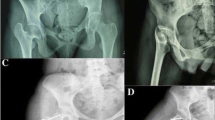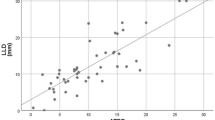Summary
The difference in altitude between the proximal limit of the femoral head and the tip of the greater trochanter — the articulotrochanteric distance (ATD) —was recorded in 312 patients with slipped capital femoral epiphysis and compared with that in normal hips. The ATD was markedly reduced after severe slipping, independent of the method of treatment. In mild or moderate slippings, the ATD differed with the method of treatment. The shortest ATD was seen after osteosynthesis with AO screws. Nonoperative treatment and osteosynthesis with the Johansson nail or Nyström pin caused a slight reduction of the ATD, while no reduction was seen after hook-pinning. These differences probably reflect various degrees of damage to the subcapital growth plate, which may result in leg length difference and abduction insufficiency.
Similar content being viewed by others
References
Bianco AJ Jr (1966) Treatment of slipping of the capital femoral epiphysis. Clin Orthop 48:103–110
Cameron HU, Wang M, Koreska J (1978) Internal fixation of slipped capital femoral epiphysis. Clin Orthop 137:148–153
Edgren W (1965) Coxa plana. A clinical and radiological investigation with particular reference to the importance of the metaphyseal changes for the final shape of the proximal part of the femur. Acta Orthop Scand [Suppl] 84
Eliasson P, Hansson LI, Kärrholm J (1988) Displacement in femoral neck fractures. Acta Orthop Scand 59:361–364
Hägglund G, Hansson LI, Sandström S (1987) Slipped capital femoral epiphysis in southern Sweden. Long-term results after nailing/pinning. Clin Orthop 217:190–200
Hansson LI (1982) Osteosynthesis with the hook-pin in slipped capital femoral epiphysis. Acta Orthop Scand 53:87–96
Hansson LI, Hägglund G, Ordeberg G, Sandström S (1988) The calcar femorale as a landmark in hip physiolysis. Acta Orthop Scand 59:134–138
Howorth B (1966) The bone pegging operation for slipping of the capital femoral epiphysis. Clin Orthop 48:79–87
Jerre T (1950) A study in slipped upper femoral epiphysis. Acta Orthop Scand [Suppl] 6
Langenskiöld A, Salenius P (1967) Epiphyseodesis of the greater trochanter. Acta Orthop Scand 38:199–219
Larsson S, Friberg S (1987) Complications at extraction of the ASIF epiphysiolysis screws. Acta Orthop Scand 58:483–484
Mau C (1927) Zur Frage der Reposition der traumatischen Epiphysenlosung am Oberschenkelhals. Arch Orthop Unfallchir 53–63
Ordeberg G, Hansson LI, Sandström S (1987) Slipped capital femoral epiphysis in southern Sweden. Long-term results with closed reduction and hip plaster spica. Clin Orthop 220:148–154
Wiberg G (1959) Considerations on the surgical treatment of slipped capital femoral epiphysis with special reference to nail fixation. J Bone Joint Surg [Am] 41:253–260
Author information
Authors and Affiliations
Rights and permissions
About this article
Cite this article
Ordeberg, G., Hägglund, G., Hansson, L.I. et al. Articulotrochanteric distance in slipped capital femoral epiphysis. Arch Orthop Trauma Surg 109, 191–193 (1990). https://doi.org/10.1007/BF00453139
Received:
Issue Date:
DOI: https://doi.org/10.1007/BF00453139




